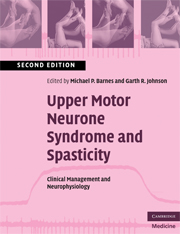Book contents
- Frontmatter
- Contents
- List of Contributors
- Preface to the second edition
- 1 An overview of the clinical management of spasticity
- 2 Neurophysiology of spasticity
- 3 The measurement of spasticity
- 4 Physiotherapy management of spasticity
- 5 Seating and positioning
- 6 Orthoses, splints and casts
- 7 Pharmacological management of spasticity
- 8 Chemical neurolysis in the management of muscle spasticity
- 9 Spasticity and botulinum toxin
- 10 Intrathecal baclofen for the control of spinal and supraspinal spasticity
- 11 Surgical management of spasticity
- 12 Management of spasticity in children
- Index
- References
4 - Physiotherapy management of spasticity
Published online by Cambridge University Press: 22 August 2009
- Frontmatter
- Contents
- List of Contributors
- Preface to the second edition
- 1 An overview of the clinical management of spasticity
- 2 Neurophysiology of spasticity
- 3 The measurement of spasticity
- 4 Physiotherapy management of spasticity
- 5 Seating and positioning
- 6 Orthoses, splints and casts
- 7 Pharmacological management of spasticity
- 8 Chemical neurolysis in the management of muscle spasticity
- 9 Spasticity and botulinum toxin
- 10 Intrathecal baclofen for the control of spinal and supraspinal spasticity
- 11 Surgical management of spasticity
- 12 Management of spasticity in children
- Index
- References
Summary
In the past, much of the controversy about the management of spasticity has been due to a lack of commonly accepted definitions of the disorder, the difficulty in measuring spasticity as well as the changing nature of the motor activity limitations with growth and maturation. There was also a paucity of data to validate clinical practice. However, there is now a growing body of evidence on which to base clinical practice. While many disciplines are involved in the management of spasticity, physiotherapists have a unique role in applying their understanding of the biomechanics of movement to the analysis of motor activity limitations and their knowledge of motor learning principles to reduce activity limitations. The emphasis of this chapter is on improving muscle performance in order to enable activity rather than preparing the patient for function by affecting abnormal reflex activity. In addition, we discuss the physiotherapist's goal in using orthoses and the role of physiotherapists in pharmacological and surgical interventions. Clinical applications for children with cerebral palsy and adults after stroke are highlighted because these individuals are the largest groups with brain damage.
What is spasticity?
Spasticity is one of the impairments affecting function following brain damage. It is typical to consider the impairments associated with the upper motor neurone syndrome as either positive or negative. Negative impairments are those features that have been lost following brain damage (e.g. loss of strength and dexterity), whereas positive impairments are those features which are additional (e.g. spasticity and abnormal postures) (Jackson, 1958; Landau, 1980; Burke, 1988).
- Type
- Chapter
- Information
- Upper Motor Neurone Syndrome and SpasticityClinical Management and Neurophysiology, pp. 79 - 98Publisher: Cambridge University PressPrint publication year: 2008
References
- 7
- Cited by

